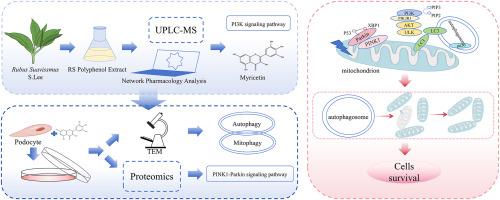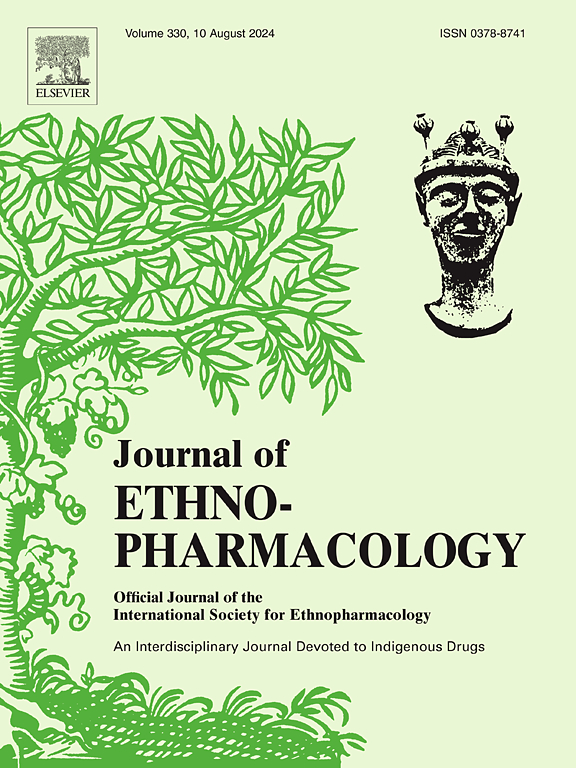杨梅素通过PI3K/Akt和PINK1/Parkin通路调控自噬在糖尿病肾病治疗中的机制研究
IF 5.4
2区 医学
Q1 CHEMISTRY, MEDICINAL
引用次数: 0
摘要
民族药理学相关性:中国广西的传统民族药红草(Rubus suavissimus S.Lee, RS)长期以来被用于治疗糖尿病及其并发症。已有研究证实RS的降糖作用及其并发症,但其作用的药理学物质基础和分子机制尚未明确。研究目的:本研究旨在阐明RS治疗糖尿病肾病(DKD)的有效成分和特定的分子机制。材料与方法:采用超高效液相色谱-串联质谱法(UPLC-MS/MS)对RS多酚提取物中的主要有效成分进行鉴定。通过网络药理学分析和富集方法筛选核心信号通路和关键活性成分。随后,在高糖、高脂条件下建立体外MPC-5足细胞模型。采用数据独立采集(DIA)质谱法分析细胞分泌组中差异表达的蛋白。透射电镜观察线粒体超微结构。Western blotting验证关键蛋白表达变化。结果:网络药理学筛选发现myricetin (Myr)是与PIK3R1结合亲和力最高的化合物,提示其是RS多酚抗dkd作用的关键活性成分。在体外,高糖高脂暴露的MPC-5细胞表现出明显的线粒体肿胀和嵴破坏。Myr处理显著保存了线粒体形态,诱导形成包裹受损线粒体的双膜自噬囊泡,表明线粒体自噬被激活。蛋白质组学分析证实了这些发现。本研究首次证明,RS多酚的主要活性成分Myr通过抑制PIK3R1发挥其治疗DKD的潜力。这种抑制促进XBP1表达,间接激活PI3K/Akt和PINK1/Parkin通路,最终增强自噬通量。结论:在DKD模型中,Myr通过靶向PI3K/Akt和PINK1/Parkin信号通路,有效激活自噬和线粒体自噬,促进功能失调线粒体的清除,减轻细胞损伤。这些发现为rs衍生的多酚在慢性肾脏疾病治疗中的应用提供了机制基础,并突出了Myr作为DKD天然治疗剂的潜力。本文章由计算机程序翻译,如有差异,请以英文原文为准。

Mechanistic insights into myricetin-regulated autophagy via the PI3K/Akt and PINK1/Parkin pathway in diabetic kidney disease treatment
Ethnopharmacological relevance
Rubus suavissimus S.Lee (RS), a traditional ethnomedicine Guangxi, China, has long been used to manage diabetes and its complications. Existing studies have demonstrated the antidiabetic activity of RS and its complications, but the pharmacological material basis and molecular mechanism of its efficacy have not been clarified.
Aim of the study
This study aimed to elucidate the active constituents and specific molecular mechanisms underlying the therapeutic effects of RS in diabetic kidney disease (DKD).
Materials and methods
Ultra-performance liquid chromatography-tandem mass spectrometry (UPLC-MS/MS) was employed to identify major active components within RS polyphenol extracts. Core signaling pathways and key active components were screened using network pharmacology analysis and enrichment methods. Subsequently, an in vitro MPC-5 podocyte cell model was established under high-glucose and high-lipid conditions. Data-independent acquisition (DIA) mass spectrometry was used to analyze differentially expressed proteins in the cellular secretome. Mitochondrial ultrastructure was assessed using transmission electron microscopy (TEM). Key protein expression changes were validated by Western blotting.
Results
Network pharmacology screening identified myricetin (Myr) as the compound exhibiting the highest binding affinity to PIK3R1, suggesting its role as a key active component in the anti-DKD effects of RS polyphenols. In vitro, high-glucose and high-lipid exposed MPC-5 cells exhibited pronounced mitochondrial swelling and cristae disruption. Myr treatment significantly preserved mitochondrial morphology and induced the formation of double-membrane autophagic vesicles encapsulating damaged mitochondria, indicative of activated mitophagy. Proteomic analysis corroborated these findings. This study demonstrates for the first time that Myr, a principal active component of RS polyphenols, exerts its therapeutic potential in DKD by inhibiting PIK3R1. This inhibition promotes XBP1 expression, indirectly activating both the PI3K/Akt and PINK1/Parkin pathways, ultimately enhancing autophagic flux.
Conclusions
Myr effectively activated autophagy and mitophagy by targeting the PI3K/Akt and PINK1/Parkin signaling pathways, facilitating the removal of dysfunctional mitochondria and mitigating cellular damage in DKD models. These findings provide a mechanistic foundation for the use of RS-derived polyphenols in chronic kidney disease management and highlight Myr's potential as a natural therapeutic agent for DKD.
求助全文
通过发布文献求助,成功后即可免费获取论文全文。
去求助
来源期刊

Journal of ethnopharmacology
医学-全科医学与补充医学
CiteScore
10.30
自引率
5.60%
发文量
967
审稿时长
77 days
期刊介绍:
The Journal of Ethnopharmacology is dedicated to the exchange of information and understandings about people''s use of plants, fungi, animals, microorganisms and minerals and their biological and pharmacological effects based on the principles established through international conventions. Early people confronted with illness and disease, discovered a wealth of useful therapeutic agents in the plant and animal kingdoms. The empirical knowledge of these medicinal substances and their toxic potential was passed on by oral tradition and sometimes recorded in herbals and other texts on materia medica. Many valuable drugs of today (e.g., atropine, ephedrine, tubocurarine, digoxin, reserpine) came into use through the study of indigenous remedies. Chemists continue to use plant-derived drugs (e.g., morphine, taxol, physostigmine, quinidine, emetine) as prototypes in their attempts to develop more effective and less toxic medicinals.
 求助内容:
求助内容: 应助结果提醒方式:
应助结果提醒方式:


